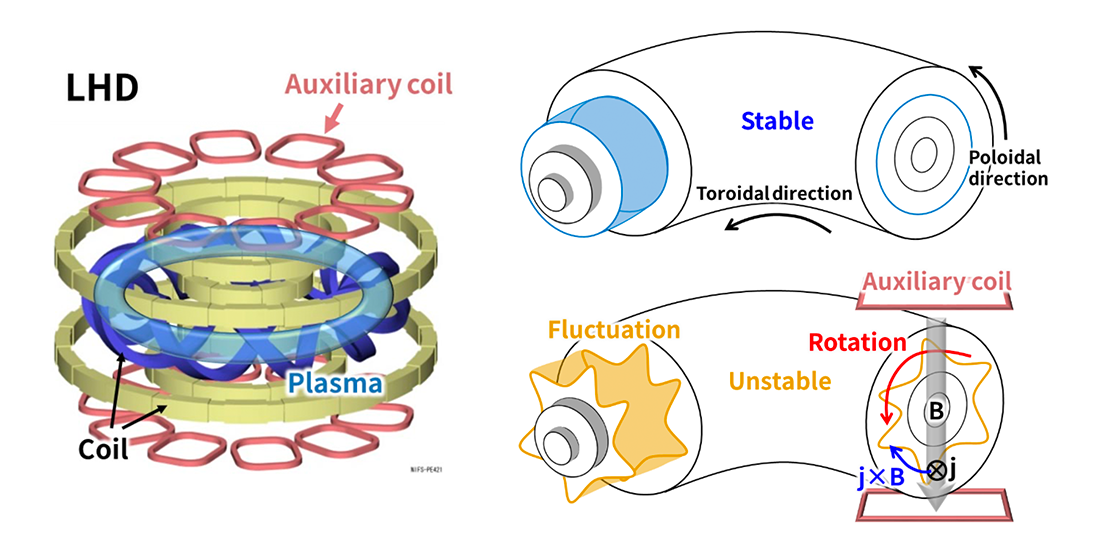Slowing-down mechanism of rotating fluctuation in magnetic confinement plasmas
In LHD a rotating fluctuation is often observed and the rotation frequency of the fluctuation sometimes decreases to almost zero. After the decrease of the frequency, the fluctuation rapidly grows and the plasma confinement performance deteriorates. In this study, the slowing-down mechanism of the rotating fluctuation is experimentally clarified. Since the slowing-down is closely related to the stability of the fluctuation, this result will accelerate the research to avoid or suppress the rapid growth of the fluctuation, which causes serious degradation of the core plasma performance.

In the magnetic confinement plasmas of the Large Helical Device (LHD), a rotating fluctuation is often observed and its frequency sometimes decreases to almost zero. After the decrease of the frequency, the fluctuation rapidly grows and the plasma confinement performance deteriorates. In this study, the slowing-down mechanism of the rotating fluctuation is experimentally clarified. Since the slowing-down is closely related to the stability of the fluctuation, this result will accelerate the research to avoid or suppress the rapid growth of the fluctuation, which causes serious degradation of the core plasma performance.
In magnetic confinement devices, the plasma is confined by nested torus surfaces composed of magnetic field lines (magnetic flux surface) as shown in the upper right figure. However, due to the collective behavior of the charged particles in the plasma, global fluctuations of the magnetic field/plasma grow, which deform the magnetic flux surface and degrade the plasma confinement performance (such a phenomenon is called magnetohydrodynamics/MHD instability). These s rotate with the plasma at an almost constant angular velocity.
On the other hand, when LHD experiments are carried out under more unstable conditions, where the fluctuations grow significantly, the angular velocity drops to almost zero, and a rapid growth of the fluctuation occurs, resulting in a serious degradation of the confinement performance (this phenomenon is called locked-mode-like instability). Similar phenomena have been observed in tokamak devices, and they are one of the key issues in magnetic confinement fusion research.
Our research group focuses on the locked-mode-like instability observed in the LHD and investigates the slowing-down mechanism of the rotation of the fluctuation, which is closely related to a severe degradation of the confinement performance. The LHD is equipped with auxiliary coils in addition to the coils that generate a strong magnetic flux surface to confine the plasma. The effect of the additional magnetic field generated by the auxiliary coils on the slowing-down characteristics is investigated. As a result, it is found that the time required from the start of the slowing-down to the stop (slowing-down time) becomes shorter when the additional magnetic field increases.
The fluctuation rotates with the plasma in a poloidal direction (see figure). A typical cause for this slowing-down of the plasma rotation is the Lorentz force (j×B force). The current j of the toroidal direction is induced in the plasma by the MHD instability (see figure). The plasma rotation slows down due to the Lorentz force if there is a magnetic field in the radial direction.
There are two types of magnetic field B, one applied by the auxiliary coils (BRMP) and the other by the eddy current induced by the MHD instability on the resistive wall of the vacuum vessel surrounding the plasma (Brw). (Here, the radial component of the ideal magnetic x surface is almost zero.) The experimental evaluation of each slowing-down force and comparison with the slowing-down time shows that the slowing-down time increases with j×Brw, while it reduce with an enhancement of j×BRMP. Since the slowing-down time is expected to deminish with the escalation of the slowing-down force, it is clear that the slowing-down mechanism in the locked-mode-like instability discharges is mainly determined by j×BRMP. Here, j×Brw is considered to be the main slowing-down mechanism in similar instabilities observed in tokamak devices.
The fluctuation growth and serious degradation of the confinement performance after the slowing-down is a common problem for both helical and tokamak devices. The present work clarifies the slowing-down mechanism and provides important knowledge for the development of stabilization methods for HD instabilities.
This study was carried out by the research group led by Yuki Takemura and Kiyomasa Watanabe at the National Institute for Fusion Science (NIFS). This research result was published on 22 December, 2020 in Nuclear Fusion, a journal on controlled thermonuclear fusion by the International Atomic Energy Agency.
